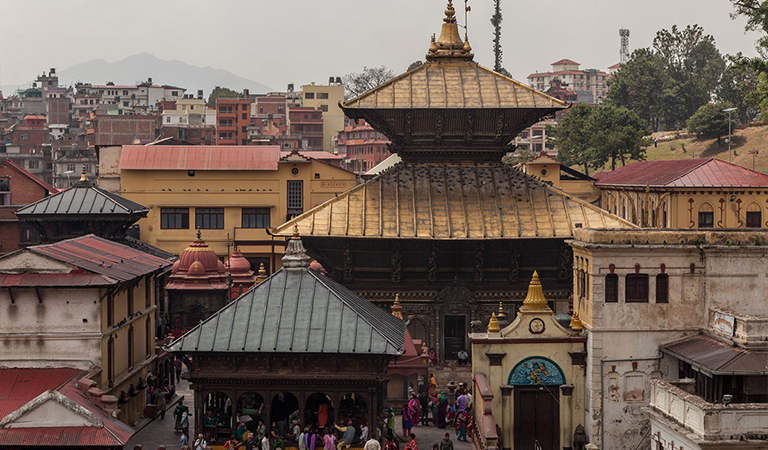Pashupatinath Temple

Pashupatinath Temple, on the banks of the Bagmati River of Nepal, is considered to be a famous pilgrimage place for Hindus. Dedicated to Lord Shiva, the temple holds great religious importance among the Hindus. The huge ancient temple complex marks its origin since the 5th century and holds a pagoda-style architecture. Due to its fine blend of architecture and culture, the temple has been declared as one of the famous UNESCO World Heritage Sites, among the other eight.
Importance of Pashupatinath Temple
Pashupatinath is regarded here as the God of Animals and is worship as the masculine counterpart of Shakti. According to the legends, Lord Shiva and Devi Parvati, being mesmerized by the beauty of the place, transform themselves into deers and stay there for eternity. The common belief is that taking a holy dip in the bathing ghats of Pashupatinath Temple releases one from the cycle of births.
Find More: Muktinath Yatra PackageBest Time to Visit
The best time to visit Pashupatinath Temple is during the months of July, August, and September to December when the weather remains very pleasant and many local festivals also take place. The major festivals which you must not leave behind are Teej Festival, Maha Shiv Ratri, and Bala Chaturthi Festival.
How to Reach
Reaching Pashupatinath Temple from Kathmandu is a very easy and smooth journey. It is at a distance of 15 kilometers from the hub of Kathmandu and thus you can get amole cabs, taxis and buses to reach the distance.
The Deity of Pashupatinath Temple
The deity of Pashupatinath Temple represents a stone Mukhalinga, with a silver serpent around it. The five faces of the idol facing West, North, East, South, and Zenith, represents the several incarnations of Lord Shiva namely, Sadyojata, Vamadeva, Tatpurusha, Aghor, and Ishana. These five incarnations indicate the natural elements of earth, water, air, light, and ether. Each face holds rudraksha in the right hand and kamandalu on the left protruding hand. The specialty of the Pashupatinath lingam is that it is dress in golden vastra.
Rituals of Pashupatinath Temple
There are two types of priests appoint at the Pashupatinath Temple, two Bhatt priests and two Bhandari priests, and only the four priests can touch the idol during the 'Abhishek'. Among them, the two Bhatt priests can only perform the daily pooja rituals while the Bhandari priests are only helpers who only take care of the temple.
Inside the Temple and Darshan
There are four cardinal entrances to the Pashupatinath Temple, the western entrance being the main one. The temple is well-maintained with equipping securities in the inner courtyard. However, only Hindus, Buddhists, Nepali, and Tibetan devotees are allowed to enter the temple premises. Other than that, no non-Hindus are allowed to enter and do darshan. However, if there are any Sikhs or Jains of Indian origin, then they are allowed inside the temple complex. Like other temples of Lord Shiva, the devotees are not allowed to enter the inner sanctum or, Garbhagriha of the temple, and can only watch from a distance.
Timings of Pashupatinath Temple
The Pashupatinath Temple opens at 4:00 AM in the morning and remains open until 9:00 PM in the evening. However, the morning rituals of the temple begin from 5:00 AM in the morning and continue till 12:00 PM in the afternoon. The evening rituals begin from 5:00 PM and continues till 7:00 PM in the evening. The devotees are allowed to enter and witness the rituals from the courtyard boundary, during both the time. The devotees can worship and pay homage to the deity from the four entrances of the sanctum from 9:30 AM to 1:30 PM. If any individual wants to perform Abhishek of the deity, then you will have to purchase a ticket from the counter, located at the entrance of the temple and costs around Rs. 1100. The timing of the deity Abhishek is from 9:00 AM to 11:00 AM in the morning. Timings of Pashupatinath Temple
Book your Pashupatinath Tour Package from Shrine Yatra to experience an abundant richness of religiosity, well-blended with the cultural magnificence of the place.